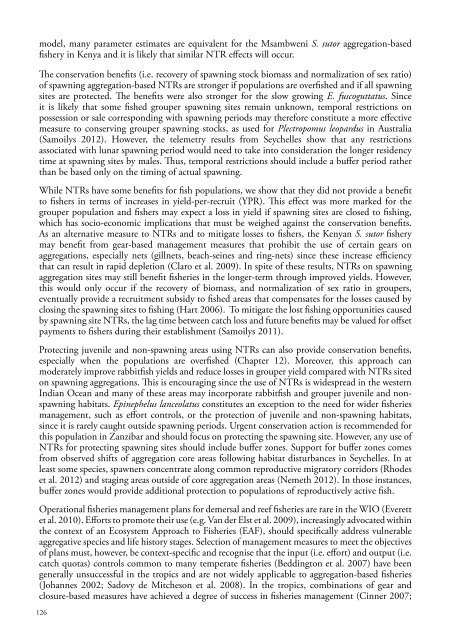WIOMSA-CORDIO spawning book Full Doc 10 oct 13.pdf
WIOMSA-CORDIO spawning book Full Doc 10 oct 13.pdf
WIOMSA-CORDIO spawning book Full Doc 10 oct 13.pdf
You also want an ePaper? Increase the reach of your titles
YUMPU automatically turns print PDFs into web optimized ePapers that Google loves.
model, many parameter estimates are equivalent for the Msambweni S. sutor aggregation-basedfishery in Kenya and it is likely that similar NTR effects will occur.The conservation benefits (i.e. recovery of <strong>spawning</strong> stock biomass and normalization of sex ratio)of <strong>spawning</strong> aggregation-based NTRs are stronger if populations are overfished and if all <strong>spawning</strong>sites are protected. The benefits were also stronger for the slow growing E. fuscoguttatus. Sinceit is likely that some fished grouper <strong>spawning</strong> sites remain unknown, temporal restrictions onpossession or sale corresponding with <strong>spawning</strong> periods may therefore constitute a more effectivemeasure to conserving grouper <strong>spawning</strong> stocks, as used for Plectropomus leopardus in Australia(Samoilys 2012). However, the telemetry results from Seychelles show that any restrictionsassociated with lunar <strong>spawning</strong> period would need to take into consideration the longer residencytime at <strong>spawning</strong> sites by males. Thus, temporal restrictions should include a buffer period ratherthan be based only on the timing of actual <strong>spawning</strong>.While NTRs have some benefits for fish populations, we show that they did not provide a benefitto fishers in terms of increases in yield-per-recruit (YPR). This effect was more marked for thegrouper population and fishers may expect a loss in yield if <strong>spawning</strong> sites are closed to fishing,which has socio-economic implications that must be weighed against the conservation benefits.As an alternative measure to NTRs and to mitigate losses to fishers, the Kenyan S. sutor fisherymay benefit from gear-based management measures that prohibit the use of certain gears onaggregations, especially nets (gillnets, beach-seines and ring-nets) since these increase efficiencythat can result in rapid depletion (Claro et al. 2009). In spite of these results, NTRs on <strong>spawning</strong>aggregation sites may still benefit fisheries in the longer-term through improved yields. However,this would only occur if the recovery of biomass, and normalization of sex ratio in groupers,eventually provide a recruitment subsidy to fished areas that compensates for the losses caused byclosing the <strong>spawning</strong> sites to fishing (Hart 2006). To mitigate the lost fishing opportunities causedby <strong>spawning</strong> site NTRs, the lag time between catch loss and future benefits may be valued for offsetpayments to fishers during their establishment (Samoilys 2011).Protecting juvenile and non-<strong>spawning</strong> areas using NTRs can also provide conservation benefits,especially when the populations are overfished (Chapter 12). Moreover, this approach canmoderately improve rabbitfish yields and reduce losses in grouper yield compared with NTRs sitedon <strong>spawning</strong> aggregations. This is encouraging since the use of NTRs is widespread in the westernIndian Ocean and many of these areas may incorporate rabbitfish and grouper juvenile and non<strong>spawning</strong>habitats. Epinephelus lanceolatus constitutes an exception to the need for wider fisheriesmanagement, such as effort controls, or the protection of juvenile and non-<strong>spawning</strong> habitats,since it is rarely caught outside <strong>spawning</strong> periods. Urgent conservation action is recommended forthis population in Zanzibar and should focus on protecting the <strong>spawning</strong> site. However, any use ofNTRs for protecting <strong>spawning</strong> sites should include buffer zones. Support for buffer zones comesfrom observed shifts of aggregation core areas following habitat disturbances in Seychelles. In atleast some species, spawners concentrate along common reproductive migratory corridors (Rhodeset al. 2012) and staging areas outside of core aggregation areas (Nemeth 2012). In those instances,buffer zones would provide additional protection to populations of reproductively active fish.Operational fisheries management plans for demersal and reef fisheries are rare in the WIO (Everettet al. 20<strong>10</strong>). Efforts to promote their use (e.g. Van der Elst et al. 2009), increasingly advocated withinthe context of an Ecosystem Approach to Fisheries (EAF), should specifically address vulnerableaggregative species and life history stages. Selection of management measures to meet the objectivesof plans must, however, be context-specific and recognise that the input (i.e. effort) and output (i.e.catch quotas) controls common to many temperate fisheries (Beddington et al. 2007) have beengenerally unsuccessful in the tropics and are not widely applicable to aggregation-based fisheries(Johannes 2002; Sadovy de Mitcheson et al. 2008). In the tropics, combinations of gear andclosure-based measures have achieved a degree of success in fisheries management (Cinner 2007;126


















